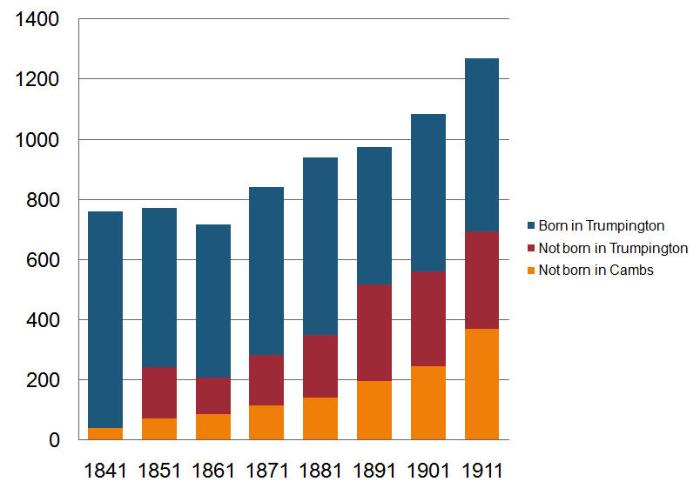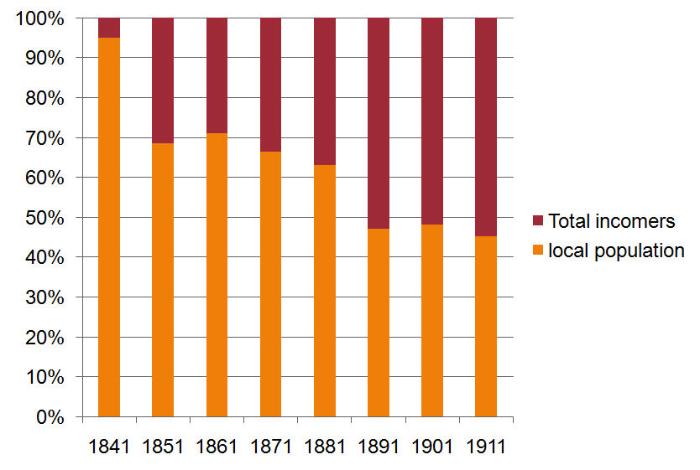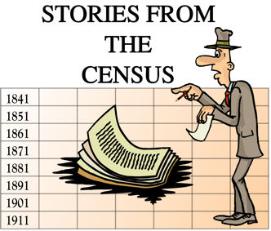December 2011
The Local History Group meeting on 24 November 2011 included presentations about Trumpington stories revealed by the censuses. This page is based on one of the presentations. There is also an introduction to the series and an overview of the Trumpington censuses for 1841-1911.
Extract from the meeting poster, designed by Sylvia Jones.
Figure 1. Population of Trumpington: where born, 1841-1911 .


From the 1851 census onwards, people were asked where they were born, so I analysed whether incomers came from close by or from further afield. I focussed on two points: how many people were born outside Cambridgeshire and how many people were born in Cambridgeshire but not Trumpington village itself.
In 1851 the total population had risen by just 12 to 771. Of these, 70 people had not been born in Cambridgeshire which is almost double the number in 1841. Most of these were skilled artisans including a tailor from Ireland, the vicar, school master, the Pembertons and staff. This is the first time we see university personnel mentioned. In addition, another 172 were born in Cambridgeshire but not in Trumpington. These people were mainly from nearby villages – Grantchester, Shelford, Foxton and were almost entirely agricultural labourers and had married local lads and lasses.
For some reason the total village population had fallen to 716 in 1861. Agricultural wages were at a low point and many people either moved to urban areas for work or emigrated. Cambridgeshire was one of the counties particularly badly hit. Despite this, more people came into Trumpington from outside Cambridgeshire (84) and this census has the first mention of houses in Hills Road which did not house general or agricultural labourers. Again, the majority of these incomers were of the professional classes (Mr Grote the vicar, schoolmistress, a telegraph engineer, the Pemberton family and staff, the policeman and a wine merchant). Of the 123 people not born in Trumpington itself, apart from a retired druggist and Mr Beebee the baker most were of the labouring class and had married local people. For the first time we have a record of someone retiring to Trumpington as I am sure the living conditions were far more pleasant than in Cambridge itself.
The major jump both in numbers of people living in Trumpington and where they came from is between 1861 and 1871. The total population had risen to 841 which is an increase of 125. Yet again there were more people (114) coming from outside the county. These included the Pembertons, for the first time the Fosters of Anstey Hall are mentioned, Robert Sayle and household, the vicar and the widow of a Doctor of Divinity. There were new houses being built along Trumpington Road. By now skilled and general labourers were moving into the village, a cordwainer, toll collector, publicans, painters and bricklayers for all the new developments. 169 people were born in the county but not born in Trumpington and again they were mainly family members and labourers but included Mr Willers the landscape gardener.
By 1881 the population had risen by another 100 people and Trumpington seems to have become a very popular place to live. There was a huge expansion of large dwellings along Trumpington Road (then called Cambridge Road) and Hills Road where the well to do who had both large families (i.e. the Borissows had 6 children at home) and several servants lived. There is more variety of jobs: a monthly nurse, coalman, a civil engineer, a dentist. Again several people had chosen to retire to the area. There are two clergymen without cure of souls, and a number of widows.
Of the 208 people not born in Trumpington itself, many were servants in the large houses, 11 agricultural labourers, shepherds, Mr Willers as nurseryman and florist and for the first time 4 domestic gardeners presumably to service the new large villas. Many of the labourers married local Trumpingtonians.
By 1891, although the total population had only increased by 25 to 975 the number of people moving in from outside the county had risen to 195. Although there were about 20 labourers, the others included the innkeeper of the Unicorn who came from Lancashire. Oddly all the publicans came from elsewhere. Several tenant farmers, 4 clergymen, the schoolmistress, a number of widows and retired people living on their own means, a surgeon, a solicitor’s clerk, the music master at a public school (possibly The Perse), the postmistress, an astronomer and a magistrate.
The number of people not born in Trumpington had also risen dramatically to 321. As before these included 16 agricultural labourers, 12 gardeners, Ellis Matthews the shepherd, but also more professional people including a Fellow of St Peters College, a solicitor, a civil engineer, Mr Munsey the silversmith and jeweller, bootmakers, florists, carpenters, a farm bailiff, painters and decorators and at least 2 retired professionals. This seems to indicate that Trumpington was a boom village where there was plenty of work available both at the university and in the new buildings. Many of the incomers married local people and settled down. Alpha Terrace was gradually being built and this is where many artisans lived, including in one census a Mr White and a Mr Gray, both painters who lived next door to each other.
By 1901, the population of Trumpington topped 1000 for the first time, of whom 50% had been born outside the village or county. By now the incomers from outside Cambridgeshire had many and varied occupations ranging from the licensees of the Unicorn and Volunteer, 5 horsekeepers, a lieutenant colonel in the Bavarian Army, an assistant director at the Victoria and Albert Museum, 2 retired doctors, a retired surgeon, the schoolmaster and pupils at St Faithâ €™s, a zoologist, a Regius Professor of Modern history, the Master of Trinity Hall, Mr Kett the builder and lots of servants in the big houses.
Once again the incomers from within Cambridgeshire tended to be broadly of the working class including, agricultural labourers, grooms, carpenter, bricklayers, a marker for the Cambridge University Rifles. Mr Willers and Mr Munsey and the retired dentist were still in residence.
The 1911 census shows a population increase of a further 200 people. Trumpington was a desirable place to live for employees at the university and there was ample work to keep gardeners, painters and bricklayers busy.
Incomers from outside Cambridgeshire now included people with many and varied occupations which would have been barely known just 10 years earlier. There was a commercial traveller in cocoa and chocolate, a director and sales manager for Portland Cement, an electrical engineer for PO telephones, a scientific instrument maker, various educational gentlemen, the President of Caius College, 2 Old Age Pensioners (pensions were introduced in 1909), dressmakers, blacksmiths, a greensman on golf links and my personal favourite – a gentleman who described himself as a “literary man”, R. Brimley Johnson, who lived at Hollydene, Shelford Road.
Incomers to Trumpington from within the county also had more varied occupations than previously including 3 solicitors, 2 domestic chauffeurs, an electrotyper, 2 plumbers, a tobacco dealer and organ grinder as well as the more mundane occupations of the past. I suspect this reflects the better education available together with new technology of the Victorian age which brought with it more opportunities for everyone.
I was very surprised when I started the research as I had not realised what a difference in class there seems to be between incomers from outside Cambridge and those from the villages surrounding Trumpington. Obviously young people from the village would meet other local young people, at fairs, markets or through the family, and if there was more work to be had in Trumpington then they would settle here after marriage. There were two large agricultural estates, Trumpington Hall and Anstey Hall, and many farms in the parish. As Cambridge extended southwards along Hills Road and Trumpington Road there was ready work in the gardens and as indoor servants. Tradesmen were also kept busy with the new constructions, both there and in Alpha Terrace and Shelford Road in the village itself. The coprolite mines brought in labourers as well. We cannot forget the growth of Cambridge University, as many dons and clergy employed there chose to live in Trumpington. There was easy access to the city and also either by road or rail to London (for instance the assistant director at the Victoria and Albert Museum). The air was also healthier than in the crowded streets of Cambridge. As many people chose to retire to the village it would seem to indicate it was a nice place to live.
